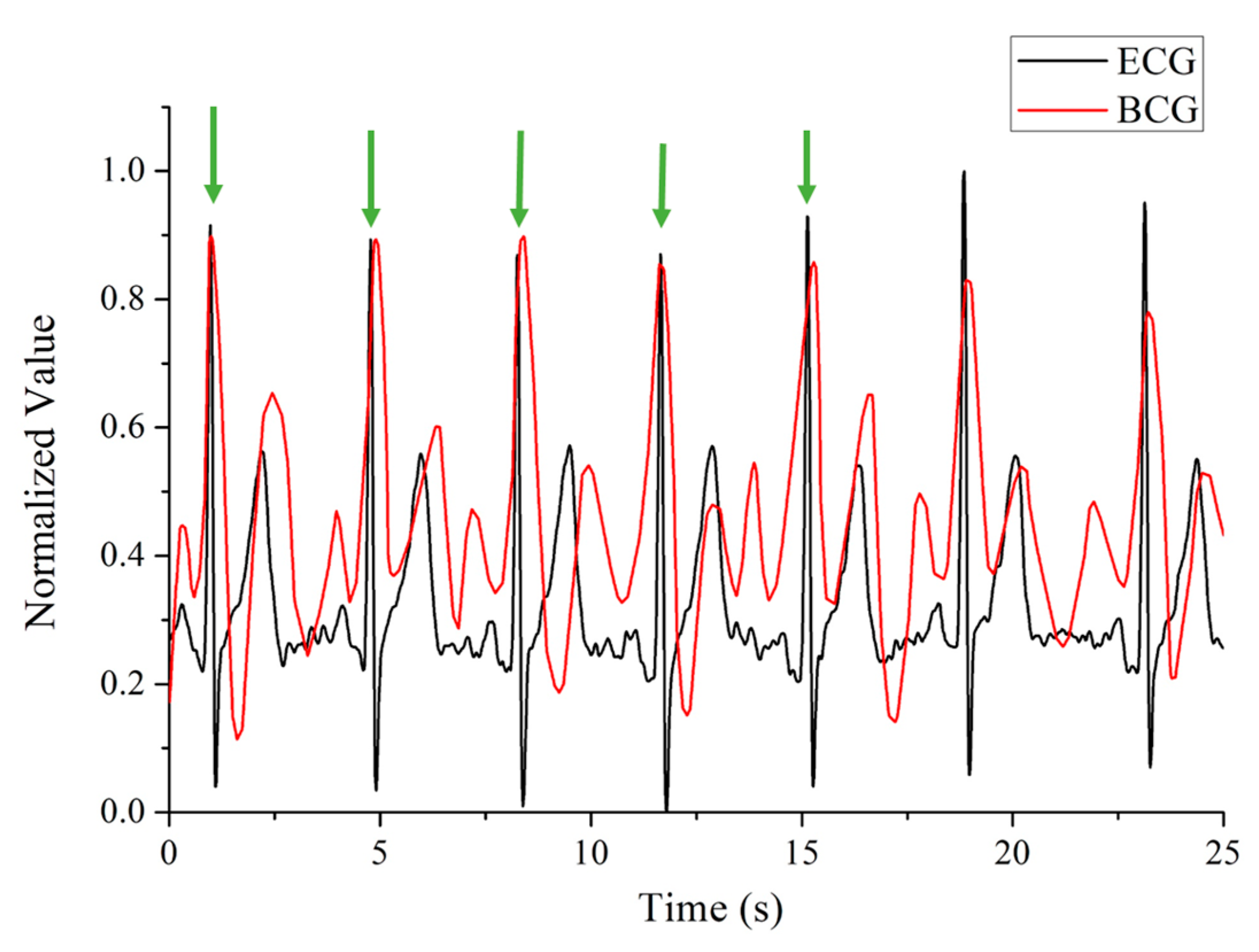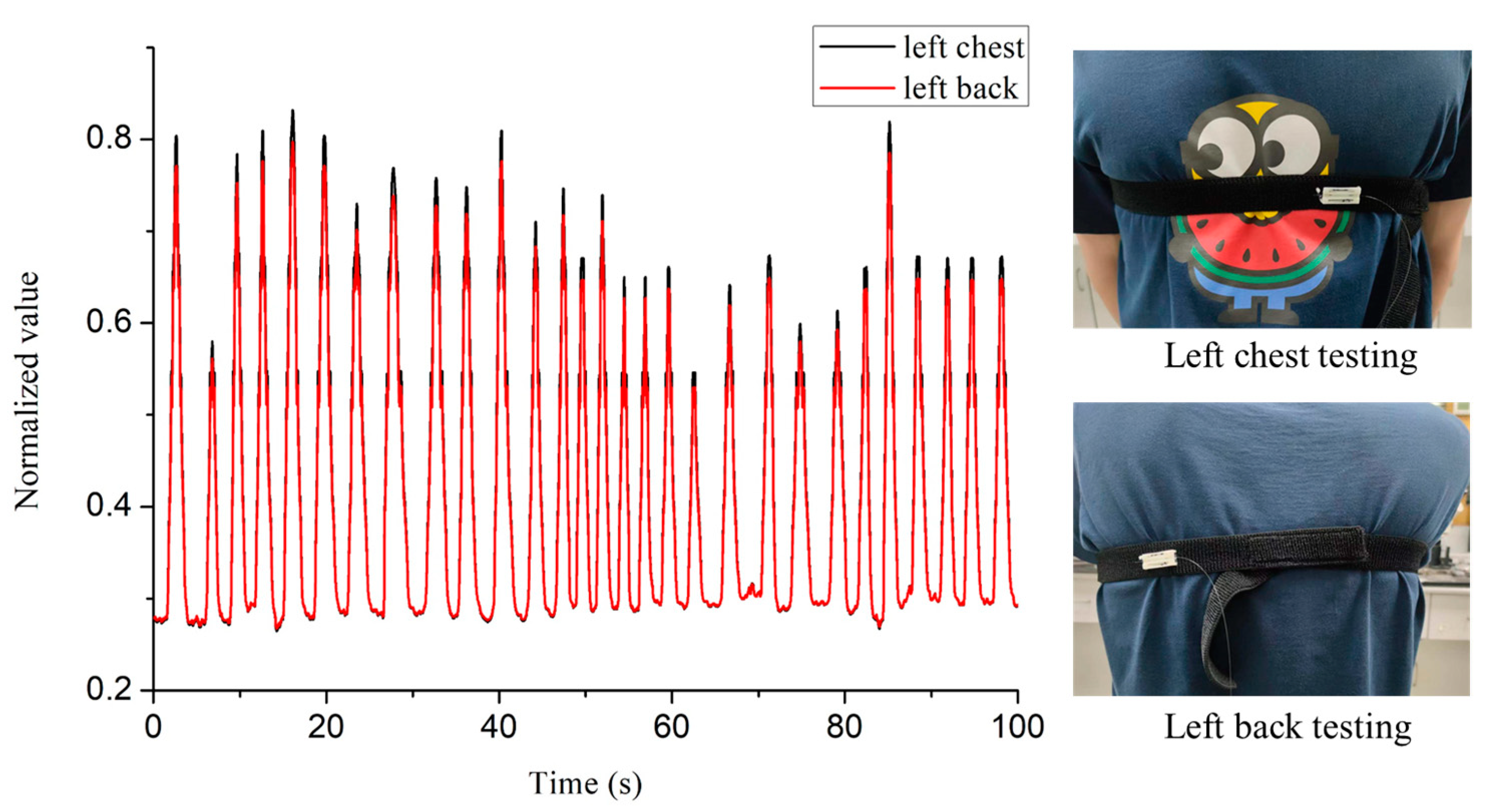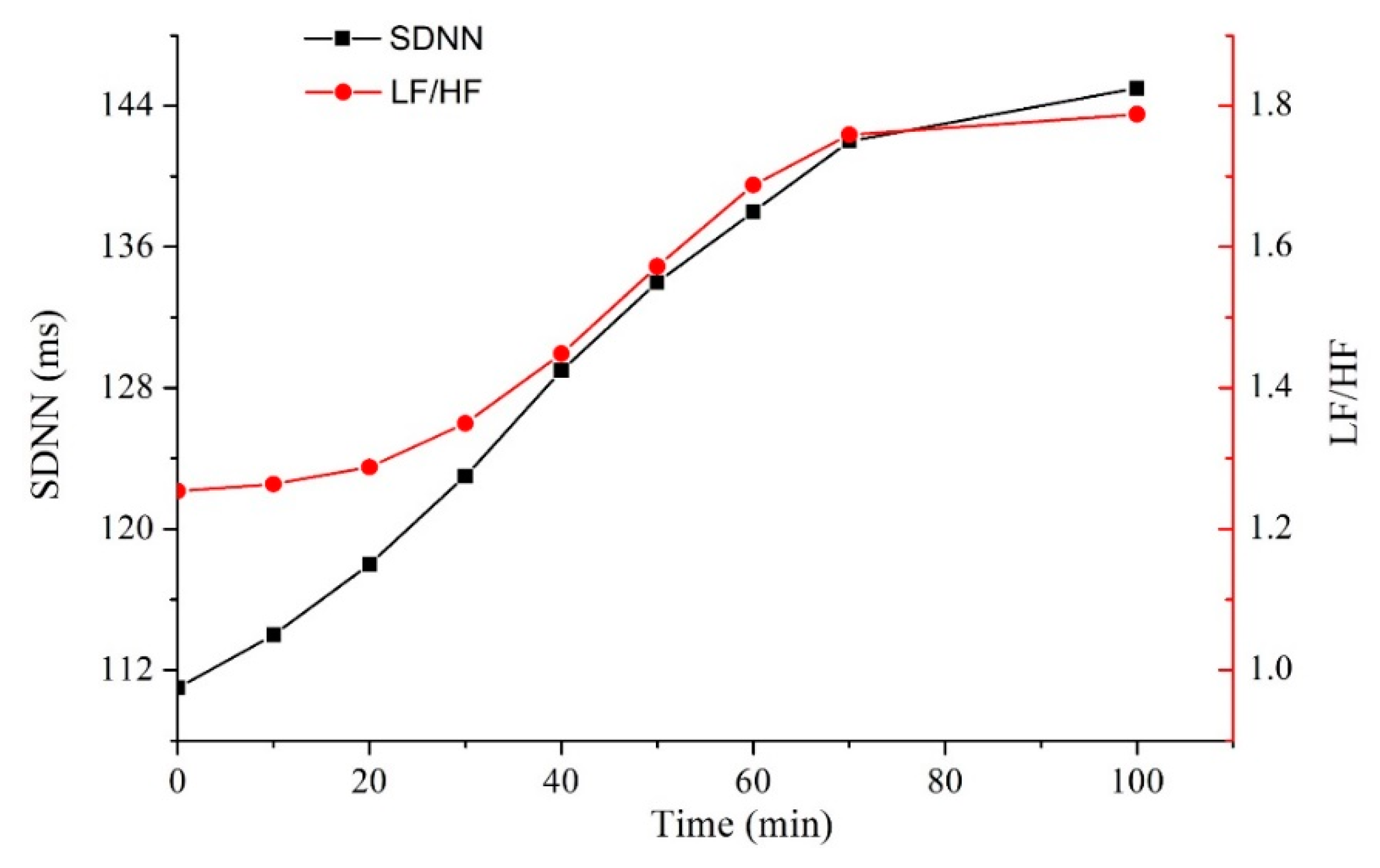Short-Term HRV Detection and Human Fatigue State Analysis Based on Optical Fiber Sensing Technology
Abstract
:1. Introduction
2. Materials and Methods
2.1. Fiber Sensor Fabrication and Packaging
2.2. Principle of the Optical Fiber Sensing System
3. Results
3.1. Experimental Process
3.2. Data Processing Method
3.3. Data Analysis
4. Conclusions and Discussion
Author Contributions
Funding
Institutional Review Board Statement
Informed Consent Statement
Data Availability Statement
Acknowledgments
Conflicts of Interest
References
- Ingles, J.L.; Eskes, G.A.; Phillips, S.J. Fatigue after stroke. Arch. Phys. Med. Rehabil. 1999, 80, 173–178. [Google Scholar] [CrossRef]
- Ke, D.-S. Overwork, stroke, and karoshi-death from overwork. Acta Neurol. Taiwan 2012, 21, 54–59. [Google Scholar] [PubMed]
- Norris, E.L.; Twiss, A.G.; Washburn, M.F. An effect of fatigue on judgments of the affective value of colors. Am. J. Psychol. 1911, 22, 112–114. [Google Scholar] [CrossRef]
- Roy, R.N.; Bonnet, S.; Charbonnier, S.; Campagne, A. Mental fatigue and working memory load estimation: Interaction and implications for EEG-based passive BCI. In Proceedings of the 2013 35th Annual International Conference of the IEEE Engineering in Medicine and Biology Society (EMBC), Osaka, Japan, 3–7 July 2013. [Google Scholar]
- Zeidner, M.; Hadar, D.; Matthews, G.; Roberts, R.D. Personal factors related to compassion fatigue in health professionals. Anxiety Stress Coping 2013, 26, 595–609. [Google Scholar] [CrossRef] [PubMed]
- Tanaka, M.; Mizuno, K.; Tajima, S.; Sasabe, T.; Watanabe, Y. Central nervous system fatigue alters autonomic nerve activity. Life Sci. 2009, 84, 235–239. [Google Scholar] [CrossRef]
- Malik, M.; Bigger, J.T.; Camm, A.J.; Kleiger, R.E.; Malliani, A.; Moss, A.J.; Schwartz, P.J. Heart rate variability: Standards of measurement, physiological interpretation and clinical use. Task Force Eur. Soc. Cardiol. N. Am. Soc. Pacing Electrophysiol. 1996, 17, 354–381. [Google Scholar] [CrossRef]
- Li, Z.; Jiao, K.; Chen, M.; Yang, Y.; Wang, C.; Qi, S. Spectral analysis of heart rate variability as a quantitative indicator of driver mental fatigue. SAE Trans. 2002, 4, 249–253. [Google Scholar] [CrossRef]
- Escorihuela, R.M.; Capdevila, L.; Castro, J.R.; Zaragozà, M.C.; Maurel, S.; Alegre, J.; Castro-Marrero, J. Reduced heart rate variability predicts fatigue severity in individuals with chronic fatigue syndrome/myalgic encephalomyelitis. J. Transl. Med. 2020, 18, 4. [Google Scholar] [CrossRef]
- Patel, M.; Lal, S.; Kavanagh, D.; Rossiter, P. Applying neural network analysis on heart rate variability data to assess driver fatigue. Expert Syst. Appl. 2011, 38, 7235–7242. [Google Scholar] [CrossRef]
- Schmitt, L.; Regnard, J.; Desmarets, M.; Mauny, F.; Mourot, L.; Fouillot, J.-P.; Coulmy, N.; Millet, G. Fatigue shifts and scatters heart rate variability in elite endurance athletes. PLoS ONE 2013, 8, e71588. [Google Scholar]
- Segerstrom, S.C.; Nes, L.S. Heart rate variability reflects self-regulatory strength, effort, and fatigue. Psychol. Sci. 2007, 18, 275–281. [Google Scholar] [CrossRef] [PubMed]
- Watson, D.W. Physiological correlates of heart rate variability (HRV) and the subjective assessment of workload and fatigue in-flight crew: A practical study. In Proceedings of the 2001 People in Control. The Second International Conference on Human Interfaces in Control Rooms, Cockpits and Command Centres, Manchester, UK, 19–21 June 2001; IET: London, UK, 2001. [Google Scholar]
- Cui, H.; Wang, Z.; Yu, B.; Jiang, F.; Geng, N.; Li, Y.; Xu, L.; Zheng, D.; Zhang, B.; Lu, P.; et al. Statistical Analysis of the Consistency of HRV Analysis Using BCG or Pulse Wave Signals. Sensors 2022, 22, 2423. [Google Scholar] [CrossRef] [PubMed]
- Nagura, M.; Mitsukura, Y.; Kishimoto, T.; Mimura, M. A practical BCG measuring system with bed sensors and algorithm for heartbeat detection. In Proceedings of the 2018 IEEE 15th International Workshop on Advanced Motion Control (AMC), Tokyo, Japan, 9–11 March 2018. [Google Scholar]
- Shin, J.H.; Park, K.S. HRV analysis and blood pressure monitoring on weighing scale using BCG. In Proceedings of the 2012 Annual International Conference of the IEEE Engineering in Medicine and Biology Society, San Diego, CA, USA, 28 August–1 September 2012. [Google Scholar]
- Li, R.; Chen, Y.; Tan, Y.; Zhou, Z.; Li, T.; Mao, J. Sensitivity enhancement of FBG-based strain sensor. Sensors 2018, 18, 1607. [Google Scholar] [CrossRef] [PubMed]
- Li, R.; Tan, Y.; Chen, Y.; Hong, L.; Zhou, Z. Investigation of sensitivity enhancing and temperature compensation for fiber Bragg grating (FBG)-based strain sensor. Opt. Fiber Technol. 2019, 48, 199–206. [Google Scholar] [CrossRef]
- Peng, J.; Jia, S.; Jin, Y.; Xu, S.; Xu, Z. Design and investigation of a sensitivity-enhanced fiber Bragg grating sensor for micro-strain measurement. Sens. Actuators A Phys. 2019, 285, 437–447. [Google Scholar] [CrossRef]
- Muralt, P.; Polcawich, R.G.; Trolier-McKinstry, S. Piezoelectric thin films for sensors, actuators, and energy harvesting. MRS Bull. 2009, 34, 658–664. [Google Scholar] [CrossRef]
- Sergio, M.; Manaresi, N.; Tartagni, M.; Canegallo, R.; Guerrieri, R. On a road tire deformation measurement system using a capacitive–resistive sensor. Smart Mater. Struct. 2006, 15, 1700. [Google Scholar] [CrossRef]
- Hao, J.; Li, W.; Zhai, J.; Chen, H. Progress in high-strain perovskite piezoelectric ceramics. Mater. Sci. Eng. R Rep. 2019, 135, 1–57. [Google Scholar] [CrossRef]
- Zhou, Z.; Graver, T.W.; Hsu, L.; Ou, J.P. Techniques of Advanced FBG sensors: Fabrication, demodulation, encapsulation and their application in the structural health monitoring of bridges. Pac. Sci. Rev. 2003, 5, 116–121. [Google Scholar]
- Cusano, A.; Cutolo, A.; Albert, J. Fiber Bragg Grating Sensors: Recent Advancements, Industrial Applications and Market Exploitation; Bentham Science Publishers: Sharjah, United Arab Emirates, 2011. [Google Scholar]
- Li, S.; Wu, Z. Sensitivity enhancement of long-gage FBG sensors for macro-strain measurements. Struct. Health Monit. 2009, 8, 415–423. [Google Scholar]
- Yu, Y.; Liu, B.; Xia, F. Design optimization of sensitivity-enhanced structure for fiber Bragg grating acoustic emission sensor based on additive manufacturing. Sensors 2022, 22, 416. [Google Scholar] [CrossRef] [PubMed]
- Chua, K.C.; Chandran, V.; Acharya, U.R.; Lim, C.M. Cardiac state diagnosis using higher order spectra of heart rate variability. J. Med. Eng. Technol. 2008, 32, 145–155. [Google Scholar] [CrossRef] [PubMed]
- Javorka, M.; Zila, I.; Balhárek, T. Heart rate recovery after exercise: Relations to heart rate variability and complexity. Braz. J. Med. Biol. Res. 2002, 35, 991–1000. [Google Scholar] [CrossRef] [PubMed] [Green Version]












| Type | Index | Definition | Formula (Unit) |
|---|---|---|---|
| Time-domain | mean value of RR intervals | ||
| SDNN | standard deviation of RR intervals | ||
| rMSSD | root mean square of differences between adjacent RR intervals | ||
| SDSD | standard deviation of the differences between adjacent RR intervals | ||
| pNN50 | the percentage of the number of NN interval > 50 ms in the total | ||
| Frequency-domain | LF | low frequency power, 0.04~0.15 Hz | FFT and Integration |
| HF | high frequency power, 0.15~0.4 Hz | ||
| LF/HF | the ratio of low frequency power to high frequency power |
| Type | Index | Awake | Mild Fatigue | Severe Fatigue | p Value |
|---|---|---|---|---|---|
| Time-domain | 786.07 ± 30.92 | 883.49 ± 36.21 | 866.08 ± 57.26 | 0.102 | |
| SDNN | 111.05 ± 7.36 | 132.61 ± 6.42 | 146.01 ± 5.72 | 0.003 1 | |
| rMSSD | 31.25 ± 2.07 | 34.68 ± 3.13 | 32.09 ± 2.40 | 0.472 | |
| SDSD | 27.21 ± 5.58 | 30.72 ± 7.25 | 39.51 ± 6.60 | 0.034 1 | |
| pNN50 | 10.63 ± 3.17 | 13.35 ± 2.40 | 12.57 ± 5.02 | 0.483 | |
| Frequency-domain | LF | 1454.93 ± 36.81 | 1541.32 ± 42.27 | 1630.63 ± 56.72 | 0.024 1 |
| HF | 1167.92 ± 40.80 | 1063.28 ± 44.01 | 912.32 ± 37.28 | 0.035 1 | |
| LF/HF | 1.25 ± 1.31 | 1.57 ± 1.02 | 1.78 ± 1.42 | 0.001 1 |
Publisher’s Note: MDPI stays neutral with regard to jurisdictional claims in published maps and institutional affiliations. |
© 2022 by the authors. Licensee MDPI, Basel, Switzerland. This article is an open access article distributed under the terms and conditions of the Creative Commons Attribution (CC BY) license (https://creativecommons.org/licenses/by/4.0/).
Share and Cite
Hu, S.; Lin, H.; Zhang, Q.; Wang, S.; Zeng, Q.; He, S. Short-Term HRV Detection and Human Fatigue State Analysis Based on Optical Fiber Sensing Technology. Sensors 2022, 22, 6940. https://doi.org/10.3390/s22186940
Hu S, Lin H, Zhang Q, Wang S, Zeng Q, He S. Short-Term HRV Detection and Human Fatigue State Analysis Based on Optical Fiber Sensing Technology. Sensors. 2022; 22(18):6940. https://doi.org/10.3390/s22186940
Chicago/Turabian StyleHu, Siqi, Huaguan Lin, Quanqing Zhang, Sheng Wang, Qingbing Zeng, and Sailing He. 2022. "Short-Term HRV Detection and Human Fatigue State Analysis Based on Optical Fiber Sensing Technology" Sensors 22, no. 18: 6940. https://doi.org/10.3390/s22186940
APA StyleHu, S., Lin, H., Zhang, Q., Wang, S., Zeng, Q., & He, S. (2022). Short-Term HRV Detection and Human Fatigue State Analysis Based on Optical Fiber Sensing Technology. Sensors, 22(18), 6940. https://doi.org/10.3390/s22186940






